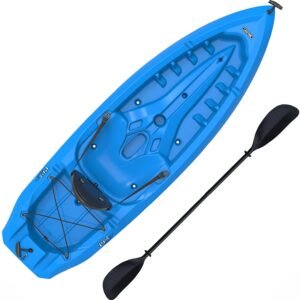The rack pictured above is the Malone SlingTwo double kayak storage system.
You’ve had a lot of fun during the kayaking season, but now that it’s over, you need to think about properly storing your kayak. But if you are relatively new to the world of kayaking, then you probably don’t quite realize how challenging kayak storage can be.
If you’ve been wondering how to properly prepare your kayak for storage and then ensure that it goes through the offseason safely and without damage, then today’s post is for you.
Why ensure special conditions for kayak storage?
The main reason for storing your kayak and kayaking equipment is because they are sensitive to outdoor elements. Namely, here are the elements that you need to care about:
Moisture: excessive moisture promotes mold growth, which is at the very least messy. In case of lighter mold contamination, you may still be able to just clean up your kayak. In more severe cases, moisture may result in outright hull degradation. And as you could guess, you would need to replace your kayaking equipment if this happened.
Sunlight: UV rays are harmless not only to people. They can significantly harm your kayaking equipment as well, so it is of prime importance to protect it from the sun. Like moisture, sunlight may plain lead to the degradation of your kayaking equipment.
Extreme temperatures: Lastly, kayaking equipment can suffer from extreme temperatures, both hot and cold.
Heat, needless to say, is going to just soften and deform your kayaking equipment. In some cases, reheating can allow you to pop your kayak back into its original shape. But it’s not always possible, so make sure to keep your kayaking equipment away from sunlight, heat sources, and from rooms that get warm.
As for cold, it doesn’t tend to directly damage kayaking equipment. However, repeated freezing and thawing can indeed damage your boat. And this means that the storage area for your kayaking equipment needs to be safeguarded from temperature fluctuations.
Options for kayak storage
Indoor kayak storage
Keeping your kayak, as well as all your kayaking equipment indoors is the best way to go about kayak storage. Indoors, it is rather easy to ensure proper storage conditions for kayaking equipment.
It doesn’t matter where to store the kayak indoors – you may keep it in your garage, storage room, and even in your living room if you are alright with that.
Outdoor kayak storage
If you don’t have any indoor room for your kayak, you can keep it outdoors. Outdoor kayak storage is perfectly possible, but you’ll need to take some extra steps to protect your equipment from the harming effects of the environment.
Here’s what you could do to protect your kayak outdoors:
Look for a shaded location. If there is any location outside your house that is constantly in shade, it is a good spot for your kayak. However, while your kayak may be safe from sunlight, it probably won’t be safe from moisture, so you’d also need to use a tarp to physically protect the kayak.
Suspend a trap over the kayak. A tarp would be able to protect your kayak both from moisture (rain and snow) and sunlight.
You should ensure that the tarp isn’t in contact with the kayak since it could promote mold growth in moist environments. Suspending the tarp over the hull is the best option. But you’d need to make sure that the tarp doesn’t fill with water or snow: if the heavy tarp presses down onto the kayak, it may deform its hull.
Use a UV protectant. A UV protectant would be able to provide your kayak with an additional protective layer. Using it will reduce the risk of sunlight damaging to your kayak.
But don’t think that you could just apply a layer of protectant onto your kayak hull and then put it outside without additional protection. A combo of a shaded area, a tarp, and a UV protectant will work much better.
How to store your kayak?
Be it indoors or outdoors, how do you store a kayak exactly? Below are the most crucial things that you need to consider.
Clean your kayak
First of all, you will need to completely clean your kayak. Make sure to remove all salt, sand, and dirt from the kayak’s hull. Do a deep cleaning in all the nooks and crannies – even though your kayak is out of water, remains of salt or dirt could cause degradation or mold contamination.
Usually, a simple freshwater rinse is going to be enough. But if you feel that the mess on the kayak is stubborn, use a mild soap and water solution. Avoid strong chemicals since they could easily degrade the kayak.
After cleaning your kayak, let it dry and air out before putting it away.
Use a rack or straps
If you thought that you could just put your kayak on the ground, then you thought wrong. To protect the hull and make sure that it doesn’t deform, you’d need to use a kayak storage rack or straps.
You could purchase commercially-made racks in a local store or from an online retailer. This would be the easier way to go, but if you don’t want to or can’t purchase a rack or straps, you could make them yourself.
Either with a rack or straps, the best way of storing your kayak is placing it upside down with the hull up. If you were to store the kayak hull-down, its delicate bottom would just deform. And with straps, you’d need to make sure that they are not so tight that the kayak hull gets dents in it.
Distribute the weight of the kayak evenly
No matter whether you use racks or straps, you need to make sure that the kayak’s weight is distributed evenly. Uneven weight distribution could easily cause the kayak’s hull to deform. Due to this, the kayak needs to be supported at evenly distributed points along its length.
One good option is to use wide nylon straps or padded cradles that match the curve of the hull. Usually, supporting the boat at points located one-third lengths away from each end allows for good weight distribution.
Protect your kayak from thieves
Kayaks can be quite pricey, and you definitely wouldn’t want yours to get stolen one day.
Storing your kayak indoors is the best option for thief protection. However, if that’s not possible for you, consider these three options:
- Keep your kayak away from view as much as possible.
- Place a vehicle steering wheel lock across the kayak’s cockpit. This will make the kayak unusable with the lock on and will make the kayak less appealing to thieves.
- Thread a security cable through a strong part of the kayak and lock it into a durable fence, post, or a building.
What about kayaking accessories?
Things are much, much easier with kayaking accessories. They should be stored outdoors as well, and since kayaking accessories like your paddle or the spray skirt are much smaller than the kayak itself, it should be very easy for you to find free room for them.
Like it was with your kayak, you should do a complete cleaning of your kayak accessories. Make sure to remove all dirt and salt from them. Rinse the equipment with freshwater and use a mild cleaning solution if necessary. And after letting the stuff dry, put them away in a dedicated storage area.
Final words
Kayak storage is challenging, but it is perfectly doable if you have the right gear. Even if you don’t have it, you can easily buy or even make it if you enjoy DIYing.
Nonetheless, it is imperative that you ensure proper storage conditions for your kayak so that it stays in tact and requires minimal preparation at the beginning of the next season!
If you don’t exactly know how to clean and otherwise maintain your kayaking gear, make sure to check out our post on kayak maintenance.


